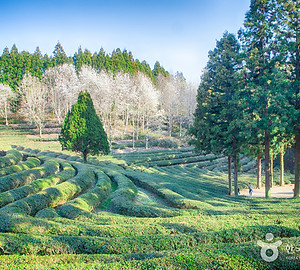
BOSEONG
Boseong is famous for its green tea leaves. It is also the birthplace
of the Korean independence activist Philip Jaisohn.

BOSEONG GANGGOL TRADITIONAL VILLAGE
Ganggol village is one of the few remaining hanok villages from the Joseon dynasty that has maintained its original look. About 30 houses stand closely together with Obongsan Mountain located behind the village. Old cherry blossom, magnolia, and pomegranate trees stand throughout the village, protecting the houses. Stone walls between the houses are covered with ivy and bamboo.
In the Ganggol Village Experience Program, participants spend a night at the traditional Hanok village where Koreans actually lived during the Joseon dynasty to experience the lifestyle of the old days (using conventional toilets and getting water from a well, etc.). An eco-experience program runs from spring to fall and offers participants a chance to catch clams and mud shrimp at Deungnyangman Bay.
Address: 15-9, Yeokjeon-gil, Boseong-gun, Jeollanam-do
TEL: +82-61-853-2885
Website: http://gg.invil.org/index.html

KOREA TEA CULTURE PARK
Korean Tea Culture Park was established in honor of Boseong's specialties of green tea and music. The park is located next to the famous green tea fields in Boseong, which draw over 3 million visitors every year. The park is comprised of Korean Tea Museum, Soricheong Performance Hall, and Bungnu Pavilion, and hosts a wide range of performances throughout the year.
Address: 775, Nokcha-ro, Boseong-gun, Jeollanam-do
TEL: +82-61-852-0918
Website: http://www.boseong.go.kr/teaeng

DINOSAUR TRACKSIDE OF HWASUN
The Dinosaur Trackside of Hwasun was discovered in 1999 during a land survey for the construction of Hwasun Hot Springs Area. Most dinosaur tracks found in Korea are located in coastal areas in cities like Haenam and Boseong, so the discovery in the inner region of Jeollanam-do was a first. Most prints here come from carnivorous dinosaurs of the Cretaceous period. The site is famous for there being tracks from no fewer than five different dinosaurs, as well as for being one of the longest trails and most direct examples of the exact movements of the dinosaurs. The tracks of one dinosaur are the longest in the world, stretching for 40 meters. In addition to the carnivorous dinosaurs, tracks were found of 12 herbivorous dinosaurs, as well as fossilized plants. These plants offer much assistance in the research of herbivorous dinosaur diets.
Address: 2080, Baega-ro, Hwasun-gun, Jeollanam-do
TEL: +82-61-379-3503

DAEHAN DAWON TEA PLANTATION
Daehan Dawon Tea Plantation produces high-quality green tea and is a popular tourist attraction year-round thanks to the vast rows of tea trees that line the hillside like a deep green carpet. Despite being a small peak at just 350 meters above sea level, the observation deck offers views of the sea on clear days. Daehan Dawon Tea Plantation has been featured as a filming site in dramas such as “Summer Scent (2002),” “Legend of the Blue Sea (2017),” and “The Rebel (2017).”
Address: 763-67, Nokcha-ro, Boseong-gun, Jeollanam-do
TEL: +82-61-852-4540
Website: http://dhdawon.com/

GANGJIN DAWON
Gangjin Dawon is a beautiful landscape of green tea fields located at the southern foot of Wolchulsan Mountain. The area’s big temperature difference between day and night and the frequent thick fog provide ideal conditions for tea cultivation. The tea here has a strong scent and rarely tastes bitter. Gangjin Dawon is the home of the nation’s first green tea product “Baegunokpancha” that was produced up until the independence of Korea in 1945. Since 1980, an extensive area of mountainous territory has been cultivated for green tea production to become the more than 80 acres of green tea fields that it is today. As Gangjin Dawon is relatively lesser known than the green tea fields in Boseong, visitors can enjoy a leisurely time surrounded by the vastness of the green tea fields.
Address: 93-25, Baegun-ro, Gangjin-gun, Jeollanam-do
Website: https://www.osulloc.com/kr/en

DAEWONSA TEMPLE
Daewonsa Temple has a full south aspect with the Cheonbongsan Peak slightly on its right. It had about 10 buildings before the Korean War, but most buildings were burned during Yeosu-Suncheon Military Revolt. Fortunately, the Hall of Paradise remains. The temple has a long history. It has 3 rooms on the front and 2 rooms on the side with a gabled-roof with multiple brackets. The rubble stone foundation was made over 1m high on the front. The foundation layer on both sides and the rear side is lower. The stairs were made in the middle of the front side.
Address: 506-8, Juksan-gil, Mundeok-myeon, Boseong-gun, Jeollanam-do
TEL: +82-61-852-1755
Website: http://www.daewonsa.or.kr/
